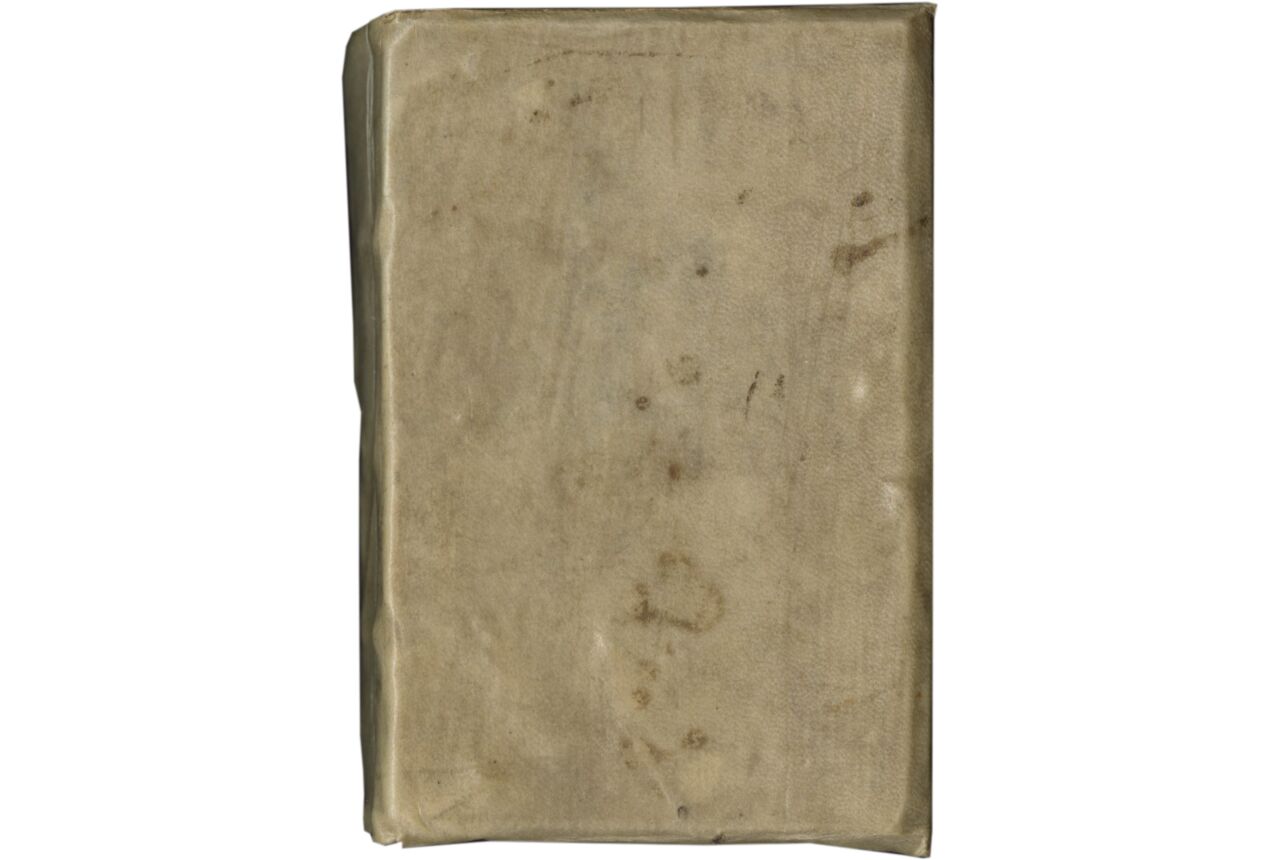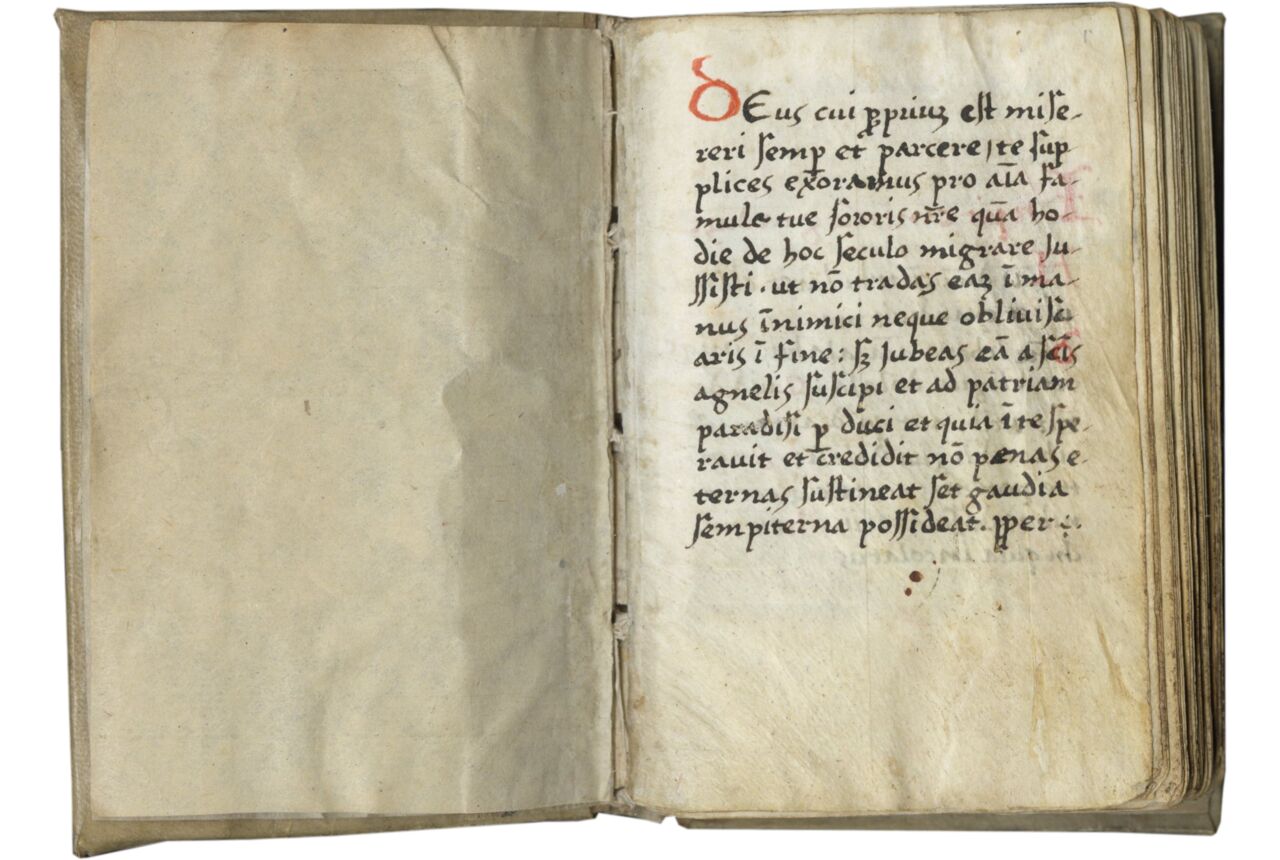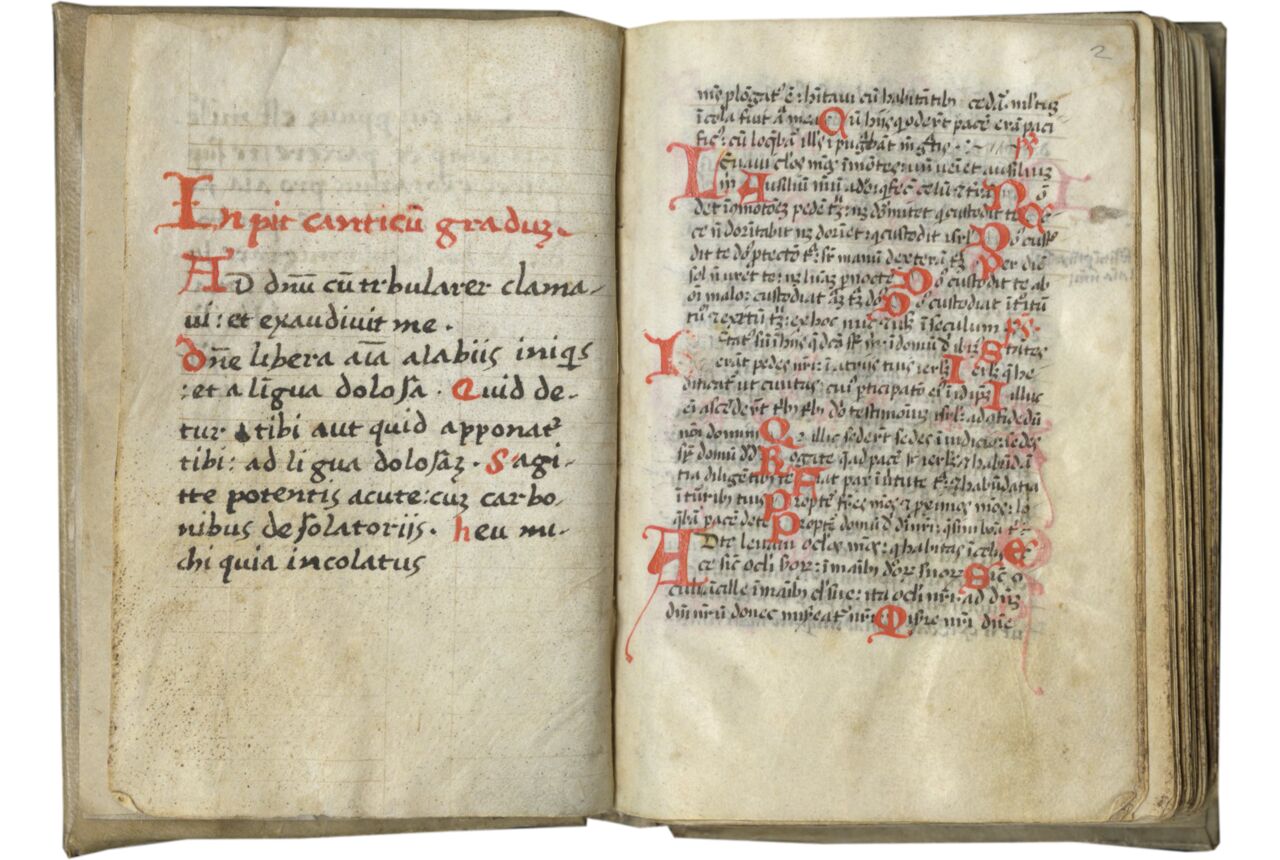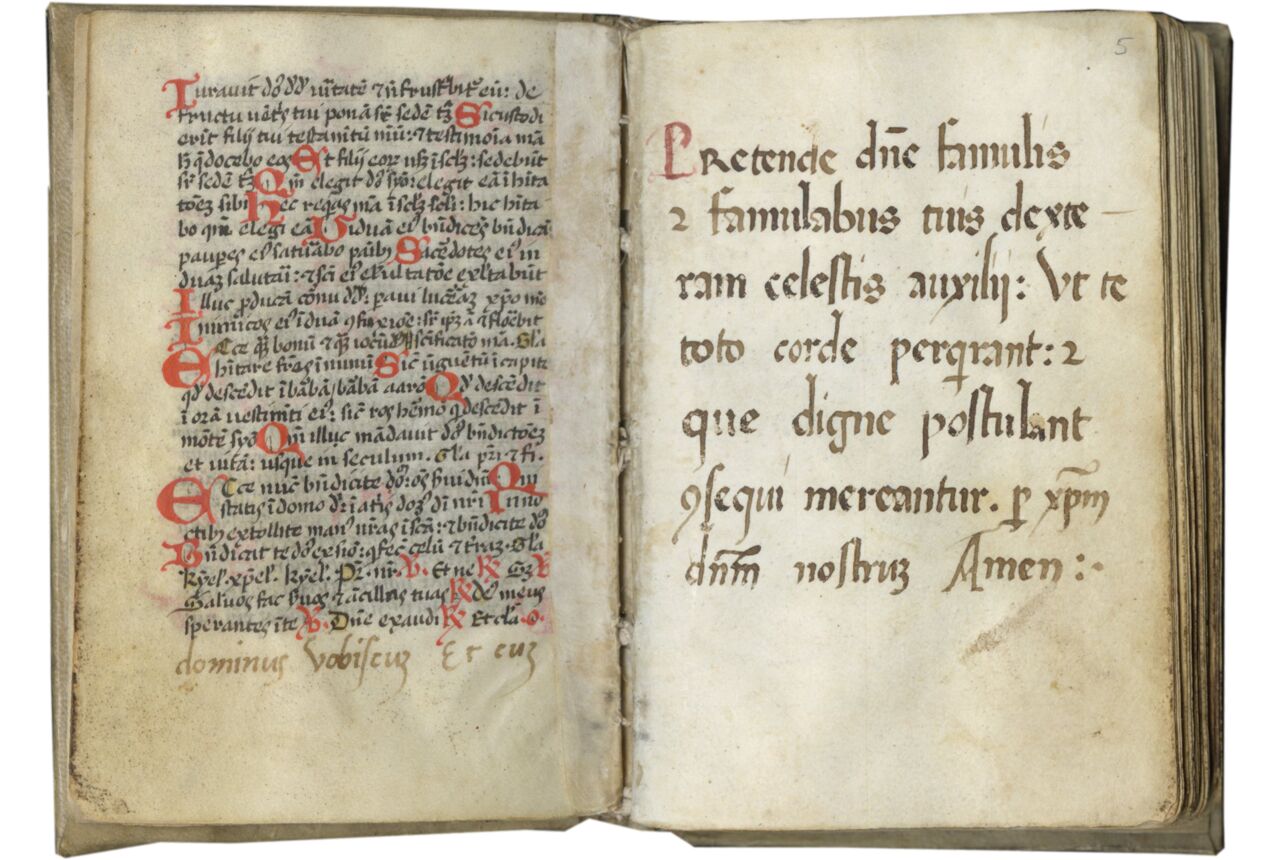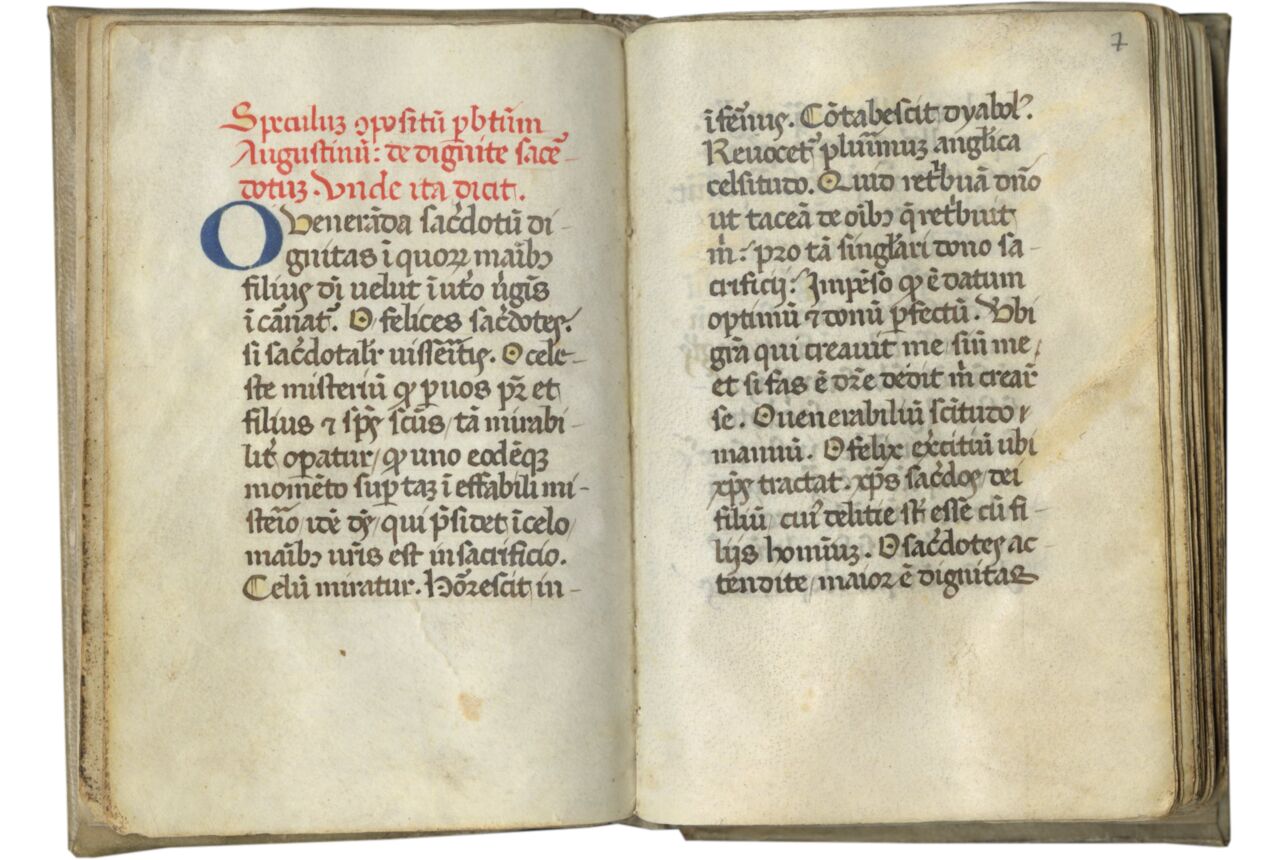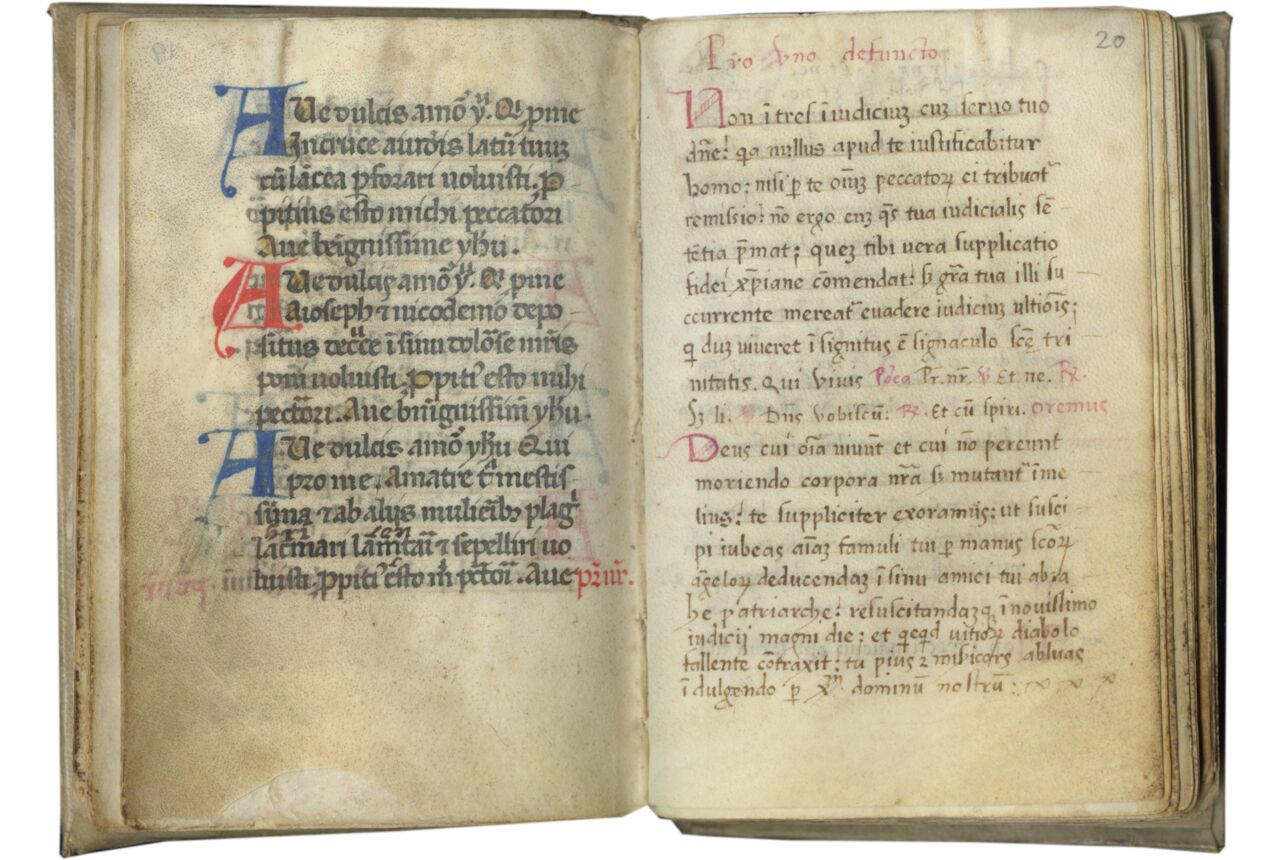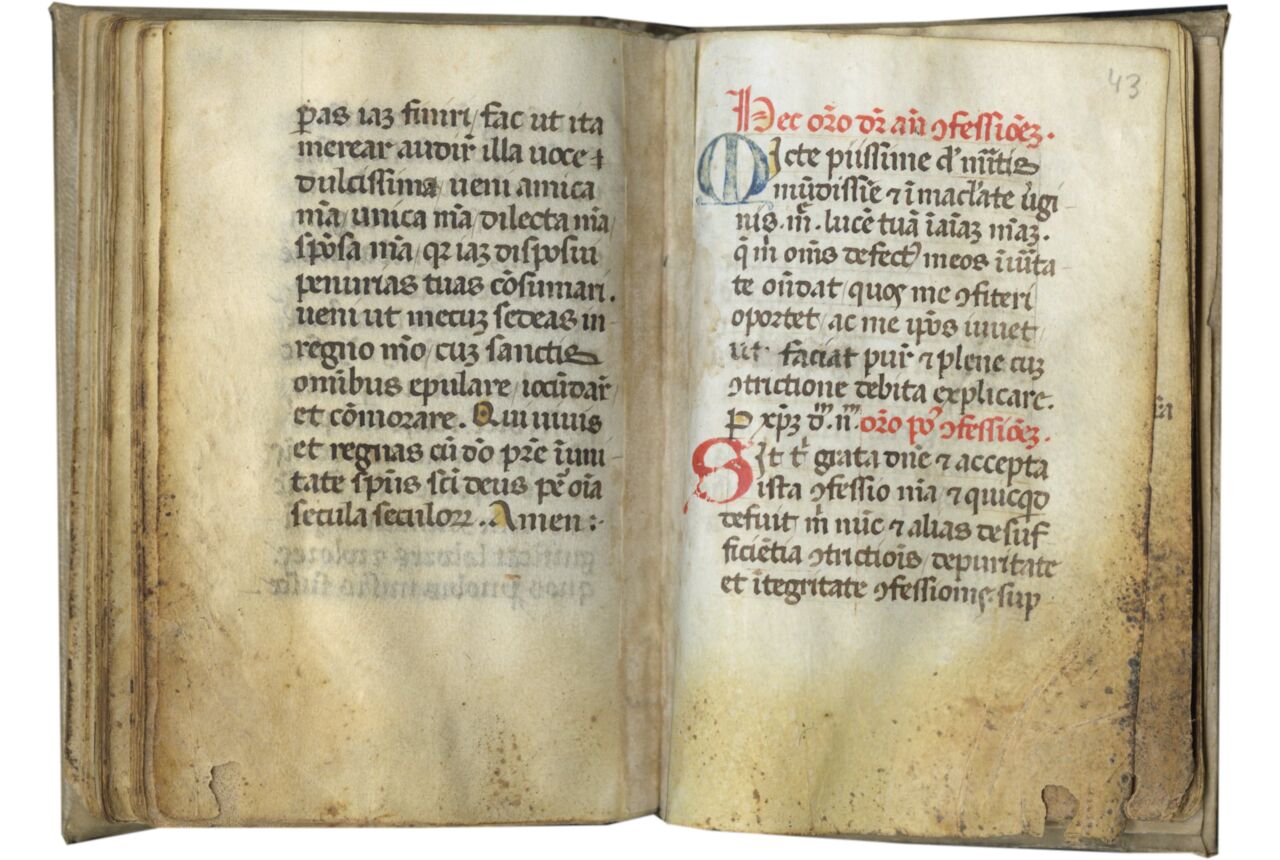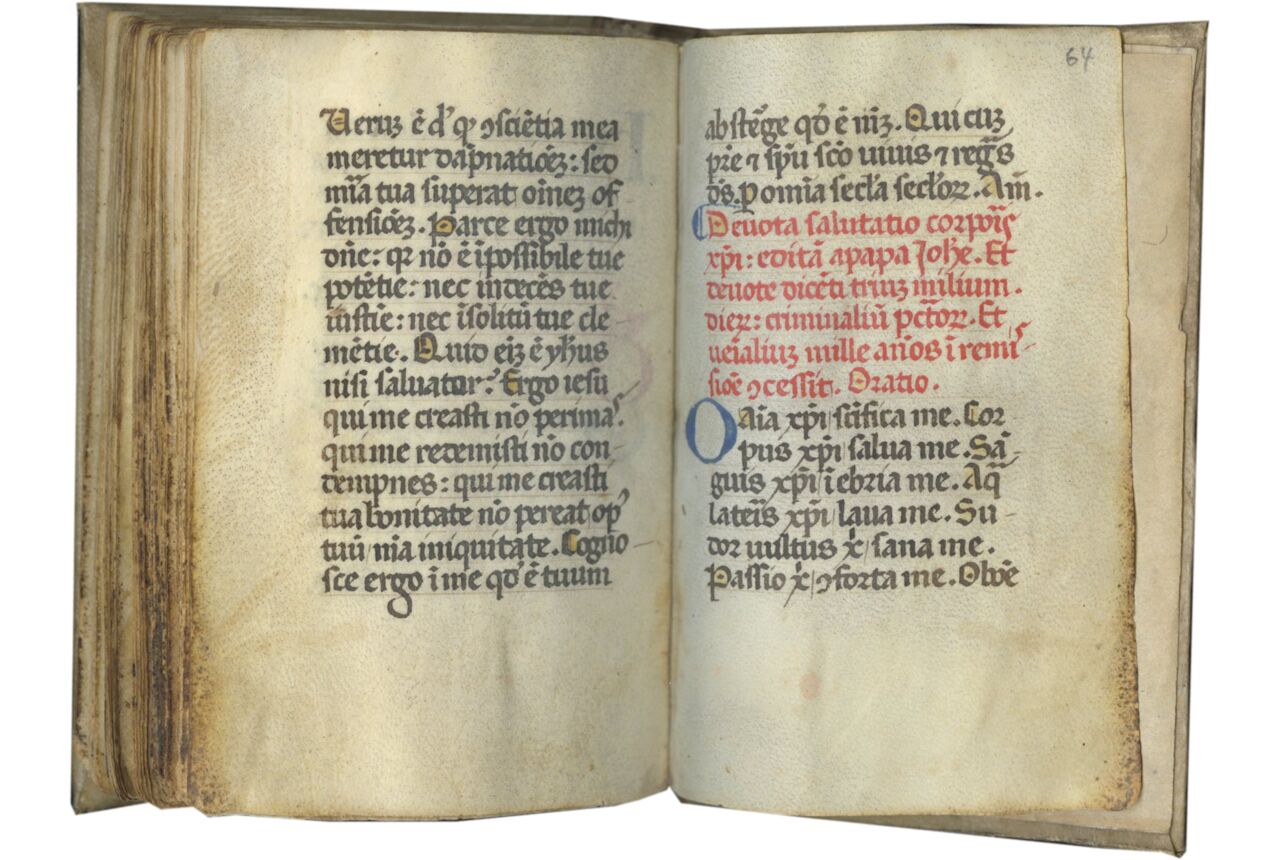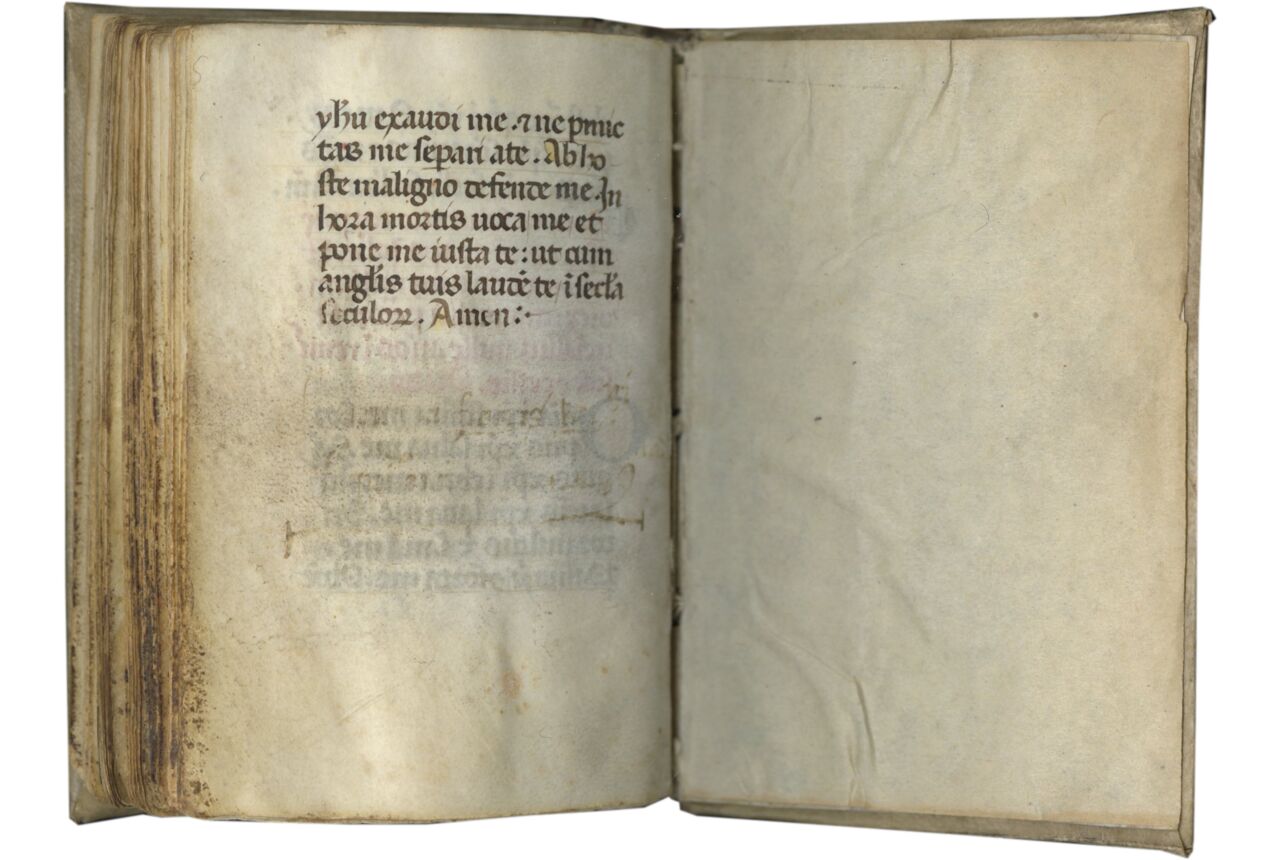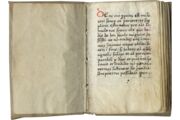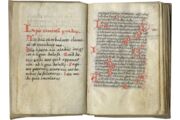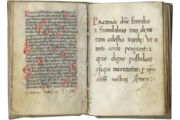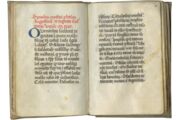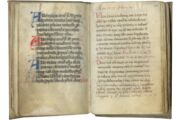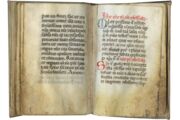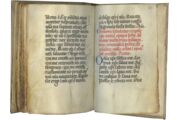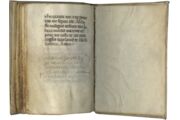i + 64 + i folios on parchment, modern foliation in pencil, 1-64, complete (lacking two blank leaves) (collation i6 [-3, -4, lacking two blank leaves after f. 2] ii8 iii-v10 vi12 vii10), horizontal catchwords (visible on ff. 32v, 54v), ruled in pale reddish brown ink (justification c. 63 x 40 mm.), written by three or more different scribes (scribe 1 copied most of the manuscript, scribe 2 copied ff. 1-5 (all or part), scribe 3 copied ff. 20-22v) in brown ink in gothic Italian rotunda bookhand in single column on c. 15 lines (the addition on ff. 20-22v in contemporary Italian hybrida bookhand mercantesca), rubrics in red, paragraph signs in blue or red, capitals touched in yellow, 1- to 3-line initials alternating in red and blue, some with penwork flourishes in the opposite color, added texts with 1- to 2-line initials in red, several stains, especially in the lower margins, showing signs of frequent use by holding the book open with thumbs in the lower corners of the book, original holes and imperfections to the parchment leaves, otherwise in overall good condition. Bound in the sixteenth century in vellum over wooden boards, front and back covers have beveled edges, flat spine, stained, but in overall good condition. Dimensions 102 x 68 mm.
A medieval Augustinian priest owned this easy-to-carry Prayerbook and Manual, which facilitated his daily duties in his community. Copied in a handsome and clear script, the text is decorated with bold initials of refined simplicity. The preparation prayers for the Holy Eucharist, including those composed by St. Ambrose and St. Anselme of Canterbury, would have made it a perfect companion for the private devotions of an Augustinian canon or friar.
Provenance
1. This manuscript was made for Augustinian use. The work contained in this manuscript was composed by an Augustinian canon regular or an Augustinian Friar, as indicated the first rubric “presbiterum Augustinum” (Augustinian priest) on f. 6v. The prayers to St. Ambrose, bishop of Milan (ff. 23-28v), who helped to convert Augustine of Hippo (354–430) to Christianity, and the prayers to St. Anselm of Canterbury (ff. 63-64), the eleventh century philosopher who developed Augustine’s theology, provide further evidence for the Augustinian use of the book. The style of the script suggests localizing the making of the manuscript in northern Italy, probably in the third quarter of the fifteenth century. Furthermore, the manuscript is written on goat skin, which was used in Italy. The decoration of the initials is reminiscent of the twelfth- and thirteenth-century initials found in France, and in northern Italy illuminators often imitated French forms.
2. Erased ownership inscription after the end of the text on final leaf, f. 64v, now illegible.
3. Belonged at the end of the nineteenth century to the canon of Sens, Zozime Beau, whose donation inscription is found on the front pastedown: “Orationes super missam. Don de M. Zozime Beau, chanoine de Sens, 1896”.
4. French private collection.
Text
ff. 1-5, [Originally blank; Gradual Psalms and prayers, added in several hands, fifteenth and sixteenth century], f. 1, [prayer to God to be said at the end of the litany of saints], incipit, “Deus cui proprium est misereri semper et parcere...”; ff. 1v-4v, [Gradual Psalms (Psalms 119-133)], Incipit canticum gradu(u)m., incipit, “Ad dominum cum tribularer clamavi et exaudivit me...” (notice that although the script changes on f. 2, the text continues uninterrupted from f. 1v to f. 2 in Ps. 119:5); f. 5, [prayer to God that follows the Gradual Psalms in Roman liturgical use], incipit, “Pretende domine famulis et famulabus tuis dexteram celestis auxilii...”; [ff. 5v-6, blank; these first six leaves appear to be part of the original text block];
ff. 6v-64v, Speculum compositum presbiterum Augustinum de dignitate sacerdotum unde ita dicit (Speculum, or Mirror, composed by an Augustinian canon on the dignity of the priesthood), incipit, “O veneranda sacerdotum dignitas in quorum manibus filius dei…”, ff. 8v-9v, “Actende qui celebrare vis ...”; f. 9v, “Quid cogitandum in missa ...”; ff. 9v-10, “Devotio requiritur in missa celebratione ...”; ff. 10-11, “De utilitate celebrationis misse …”; ff. 11-12v, “Hec est figura huius sacri que describitur Exodi .xii. capitulo…”; f. 13-15v, [prayer to Christ], “O domine yhesu christe adoro te in cruce pendentem...”; ff. 15v-19v, “Incipit corona yhesu christi. Ave dulcis amor yhesu qui pro me carnem...”; ff. 20-22v, [originally blank, contemporary addition in hybrid bookhand, prayers for the deceased], “Pro uno defuncto,” “Pro defuncta femina,” “Pro pluribus defunctis”; ff. 23-28v, [the famous prayer to be said in preparation for the Mass, attributed to St. Ambrose of Milan], Oratio sanctii Ambrosii episcopi ante missam dicenda, incipit, “Summe sacerdos et vere pontifex yhesu christe qui te obtulisti...”; ff. 29-31, [prayer to be said before the Mass, lacking a rubric for which two blank lines were reserved], incipit, “Cum magna confusione...”; ff. 31-43v, [prayers to be said before the Mass], “Domine yhesu christe fili dei vivi....” “Omnipotens et mitissime deus ecce accedo...”; ff. 44-57, [versicles, responsories and hymns to be said in preparation of the Mass], In preparatione misse, incipit, “Deus in adiutorium meum intende”; ff. 57-60, [Office of the Holy Cross], Incipit officium sancte crucis. Ad matutinum. Versus …; ff. 60v-63, [Office of the Holy Spirit], Incipit officium spiritus sancti …; ff. 63-64, [prayer attributed to St. Anselmus of Canterbury, Oratio sancti Anselmi, incipit, “Domine deus meus si feci ut essem reus tuus …”; f. 64rv, [prayer Anima Christi composed in the entourage of Pope John XXII], Devota salutatio corporis Christi editam a papa Johanne…, incipit, “O anima christi sanctifica me ... ut cum angelis tuis laudem te in secula seculorum. Amen.”
This is a manual of prayer and Eucharistic practice for the Augustinian priest. It provides guidance on how to prepare and celebrate the Holy Eucharist, including chapters on what to think and how to act in preparation of the Mass, nurturing the mind and soul of the presider. The text contains numerous prayers for the Mass, but also for the Hours of the Cross and the Hours of the Holy Spirit. There are added prayers for the deceased on ff. 1-5 and 20-22v, including the fifteen Gradual Psalms, traditionally recited before Matins; the Gradual Psalms signify the ascent of the soul toward God.
Augustinian Canons Regular are cathedral clergy living a semi-monastic life in community, following the Rule of Saint Augustine, and are committed to their primary vocation as priests. The Canons Regular follow an ancient form of religious life that predates the founding of the friars. The Augustinian friars are mendicants who pray the liturgy of the Hours throughout the day. Several orders of Augustinian friars combine the life of contemplation and apostolic ministry; the largest of these orders is the Order of Saint Augustine (OSA), founded in 1244.
The long and famous prayer Summe Sacerdos et vere Pontifex (ff. 23-28v) is recited in preparation for the Sunday Mass. Traditionally in the Middle Ages it was attributed to St. Ambrose (340-397), as in our manuscript, but scholars today attribute it to John of Fécamp, the twelfth-century Italian-Norman Benedictine monk. The prayer was an important part of priestly private devotions and was included in the Missal by Pius V (papacy 1566-1572). Our manuscript ends on its final leaf with the prayer Anima Christi, composed in the entourage of the second Avignon Pope John XXII (papacy 1316-1344), who granted it with an indulgence. The prayer was first officially recited on Holy Thursday in 1330, and the earliest copies of it known today are two manuscripts dated 1350 in the British Library. Normally its recital assures thirty days of indulgence, but some manuscripts, like ours, promise 3000 days (cf. Passerat, 2012, pp. 447-448).
This highly interesting manuscript is a beacon on the everyday religious life of fifteenth-century Italy and the sophistication of its clergy. It is written in a very neat and easily readable script and decorated with beautiful initials.
Literature
Passerat, G. “Les prières du pape Jean XXII,” Jean XXII et le Midi, Toulouse, 2012, pp. 439-457 (Cahiers de Fanjeaux, 45).
Peterson, D. S. “Out of the Margins: Religion and the Church in Renaissance Italy,” Renaissance Quarterly 53:3 (2000), pp. 835-879.
Rano, B. Augustinian Origins, Charism, and Spirituality, Villanova (PA), 1994.
Zumkeller, A. Augustine's Ideal of the Religious Life, New York, 1986.
Online Resources
“Anima christi” in Latin and English
https://www.preces-latinae.org/thesaurus/PostMissam/AnimaChristi.html
“Summe sacerdos et vere pontifex” in Latin and English
https://www.preces-latinae.org/thesaurus/AnteMissam/OrationesSAmb.html
Augustinian Canons
http://augnet.org/en/history/general/4315-before-the-augustinians/4109-augustinian-canons-01/
Catholic Encyclopedia, “Hermits of St. Augustine”
www.newadvent.org/cathen/07281a.htm
Order of St. Augustine
http://www.augnet.org/en/history/general/4107-a-general-overview/
TM 1370


